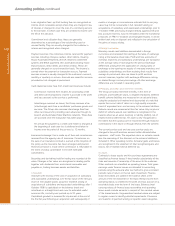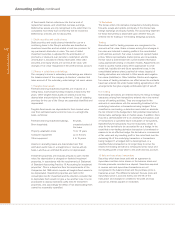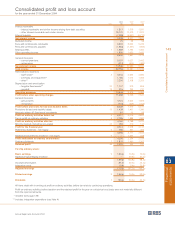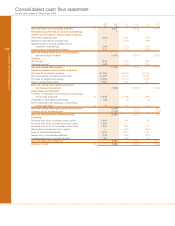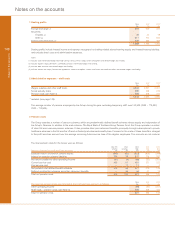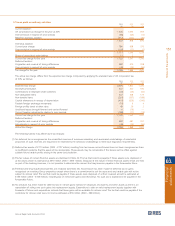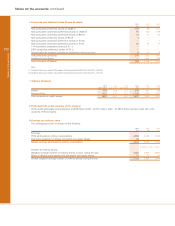RBS 2004 Annual Report Download - page 144
Download and view the complete annual report
Please find page 144 of the 2004 RBS annual report below. You can navigate through the pages in the report by either clicking on the pages listed below, or by using the keyword search tool below to find specific information within the annual report.
142
Accounting policies
of fixed assets that are rolled over into the tax cost of
replacement assets, and unremitted overseas earnings.
Deferred tax assets are only recognised to the extent that it is
considered more likely than not that they will be recovered.
Deferred tax amounts are not discounted.
11 Debt securities and equity shares
Debt securities and equity shares intended for use on a
continuing basis in the Group’s activities are classified as
investment securities and are stated at cost less provision for
any permanent diminution in value. The cost of dated
investment securities is adjusted for the amortisation of
premiums or discounts over periods to redemption and the
amortisation is included in interest receivable. Other debt
securities and equity shares are carried at fair value, with
changes in fair value recognised in the profit and loss account.
12 Shares in subsidiary undertakings
The company’s shares in subsidiary undertakings are stated in
the balance sheet of the company at directors’ valuation that
takes account of the subsidiary undertakings’ net asset values.
13 Tangible fixed assets
Freehold and long leasehold properties are revalued on a
rolling basis, each property being revalued at least every five
years. Other tangible fixed assets are stated at cost less
depreciation and provisions for impairment. Costs of adapting
premises for the use of the Group are separately identified and
depreciated.
Tangible fixed assets are depreciated to their residual value
over their estimated useful economic lives on a straight-line
basis, as follows:
Freehold and long leasehold buildings 50 years
Short leaseholds unexpired period of
the lease
Property adaptation costs 10 to 15 years
Computer equipment up to 5 years
Other equipment 4 to 15 years
Assets on operating leases are depreciated over their
estimated useful lives on a straight-line or reverse-annuity
basis. Land has an unlimited life and is not depreciated.
Investment properties are revalued annually to open market
value. No depreciation is charged on freehold investment
properties, in accordance with the requirements of Statement
of Standard Accounting Practice 19 ‘Accounting for investment
properties’. This is a departure from the requirements of the
Companies Act 1985 which requires all tangible fixed assets to
be depreciated. Investment properties are held not for
consumption but for investment and the directors consider that
to depreciate them would not give a true and fair view. It is not
practicable to assess estimated useful lives for investment
properties, and accordingly the effect of not depreciating them
cannot be reasonably quantified.
14 Derivatives
The Group enters into derivative transactions including futures,
forwards, swaps and options principally in the interest rate,
foreign exchange and equity markets. The accounting treatment
for these instruments is dependent upon whether they are
entered into for trading or non-trading (hedging) purposes.
Trading
Derivatives held for trading purposes are recognised in the
accounts at fair value. Gains or losses arising from changes in
fair value are included in dealing profits in the consolidated
profit and loss account. Fair value is based on quoted market
prices. Where representative market prices are not available,
the fair value is determined from current market information
using appropriate pricing or valuation models. Adjustments are
made to quoted market prices where appropriate to cover
credit risk, liquidity risk and future operational costs. In the
consolidated balance sheet, positive fair values (assets) of
trading derivatives are included in Other assets and negative
fair values (liabilities) in Other liabilities. Positive and negative
fair values of trading derivatives are offset where the contracts
have been entered into under master netting agreements or other
arrangements that give a legally enforceable right of set-off.
Non-trading
Non-trading derivatives are entered into by the Group to hedge
exposures arising from transactions entered into in the normal
course of banking activities. They are recognised in the
accounts in accordance with the accounting treatment of the
underlying transaction or transactions being hedged. To be
classified as non-trading, a derivative must match or eliminate
the risk inherent in the hedged item from potential movements in
interest rates, exchange rates or market values. In addition, there
must be a demonstrable link to an underlying transaction, pool
of transactions or specified future transaction or transactions.
Specified future transactions must be reasonably certain to
arise for the derivative to be accounted for as a hedge. In the
event that a non-trading derivative transaction is terminated or
ceases to be an effective hedge, the derivative is re-measured
at fair value and any resulting profit or loss amortised over the
remaining life of the underlying transaction or transactions
being hedged. If a hedged item is derecognised, or a
specified future transaction is no longer likely to occur, the
related non-trading derivative is remeasured at fair value and
the resulting profit or loss taken to the profit and loss account.
15 Sale and repurchase transactions
Securities which have been sold with an agreement to
repurchase continue to be shown on the balance sheet and
the sale proceeds recorded as a deposit. Securities acquired
in reverse sale and repurchase transactions are not
recognised in the balance sheet and the purchase price is
treated as a loan. The difference between the sale price and
repurchase price is accrued evenly over the life of the
transaction and charged or credited to the profit and loss
account as interest payable or receivable.
Accounting policies continued










